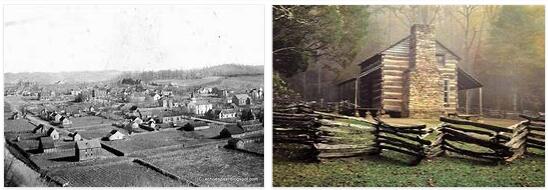Abbreviated as MS, Mississippi is one of the southern states of the North American Confederation, named after the Mississippi River which forms its western border. The state of Mississippi extends from 35 ° lat. N. up to the Gulf of Mexico, at about 30 ° lat. N., and between 88 ° 6 ‘and 91 ° 40’ long. W. The southern tip is to the S. of the 31 ° lat., Reaches westward only to the Pearl River instead of the Mississippi, and the coast of the state on the Gulf of Mexico is only 120 km long. The surface of the state of 121,375 sq km. it is divided into 82 counties, each of which consists of five beats , corresponding to the townships of some other North American states.
Except for a small strip of Paleozoic rocks at the north-eastern end, the rest of the territory rests on Cretaceous formations and on layers of limestone, marl, clay, sand, etc., of a later age, belonging to the coastal plain of the Gulf of Mexico. From the NE corner. proceeding towards SW., more and more recent layers follow one another in a regular series. The Cretaceous is encountered only in the NE quadrant; the rest of the state is largely Tertiary. The modest mineral resources consist mainly of clay and sand with small amounts of limestone, iron ore, lignite, mineral waters and natural gas. In 1930 the number of people employed in mines, quarries and gas springs was only 801, equal to 0.1% of all workers in the state.
The soil, formed by mediocre hills to the N. and NE., Where the highest elevation (237 m.) Is reached near Iuka, gradually becomes flat towards S. The alluvial plain of the Mississippi River, known locally as the Yazoo delta , is extends from corner NW. of the state along the river to Vicksburg, in a straight line of 320 km., on a width of one hundred km. in the center. It is a flat plain, interrupted only by a few rivers and marshes, and tilted imperceptibly in the direction of S. It was periodically flooded by the floods of the Mississippi, until it was protected by embankments along the banks of the river. A few km. from the coast of the Gulf of Mexico a series of narrow sandy islands form an interrupted barrier.
The Mississippi River (v.) Is navigable much further upstream from the state borders; the territory is crossed for a few kilometers. in the NE corner. from the Tennessee River, and modest navigation also takes place on some other rivers near their mouths. In the past, steamboats sailed up the Tombigbee River to Aberdeen on the NE side .; but this is no longer possible, except in periods of flood, because the cutting of the forests and the cultivation of most of the soil have, with the greater contribution of floods, determined the formation of slums, etc. The production of water energy is also minimal, due to the very low elevation of most of the territory.
The climate is temperate-warm. In the northernmost part of the state there are: average temperature in January, 4 °, 4 °; in July, 27th, 2; annual average 16 °, 4. At the extreme S. the three averages are respectively 11 °, 27 °, 2, 20 °. The average annual rainfall varies slightly as does the temperature, from about 1200 mm. in the N. a little less than 1600 mm. in the S. In the northern region the dry season is summer; in the southern one, winter. Snow and ice are rare. Mild, dry winters make the Gulf of Mexico coast, sometimes referred to as the Mississippi Riviera, a sought-after winter getaway. Tornados occur in some regions of the northern part every year, usually in spring, while hurricanes occur along the coast, usually in autumn, but less frequently.
Like most other eastern states, Mississippi was originally almost entirely forested with several species of pine, oak, and American walnut, two of cypress ( Taxodium ), Liquidambar , poplar, magnolia, and many less common trees. Numerous native and imported herb species provide grazing for cattle.
The native fauna, including bears, deer, wild turkeys and many other mammals and birds, has greatly diminished due to the spread of civilization, and is currently of little economic importance, except for oysters, shrimps and fish, along the coast of the Gulf of Mexico. The 1930 census found 1,598 people employed in Mississippi fishing and at least as many employed in the preparation of canned oysters and shrimp.
The original inhabitants of Mississippi were Indians, mainly Chickasaw in the NW, and Choctaw in the SE. Of the latter, about 1500 still remain, largely in Neshioba County and adjacent ones. The first white settlers were mostly of French and Spanish origin, along the coast; but at the beginning of the century. XIX their number was surpassed by that of the Anglo-Saxons who came from more eastern states bringing with them many black slaves.
The total population within the current state borders has grown from 74,448 inhab. in 1820 to 2,009,821 in 1930. This last figure corresponds to a density of 16.7 inhab. per sq. km. In 1930 the population, by race and by birth, was made up as follows. 49.2% Indigenous whites; 0.35% Foreign whites; 50.2% Negroes; 0.16% other races (mainly Indians and Mexicans). Mississippi is the only state of the confederacy where Negroes currently outnumber Whites.
Of the 7049 foreign whites, 1613 came from Italy, 730 from Germany, 713 from Syria and Palestine, 470 from England, 351 from Canada, 342 from Greece. About half of the Italians are settled in the Yazoo delta . There were also 3,403 Indigenous Whites with one or both Italian parents, and these too were largely settled in the delta.
In 1930 only 16.9% of the population lived in cities with more than 2,500 inhabitants, which constitutes one of the lowest percentages of urbanization in the United States. The main cities are: Jackson, the capital, with 48,282 inhabitants; Meridian, a railway center in the east, with 31,954 inhabitants; Vicksburg, on the Mississippi River, with 22,943 inhabitants; Hattiesburg, with 18,601 inhab., And Laurel, with 18,017 inhab., Both cities of the SE., And centers of the timber industry; Biloxi, on the coast, with 14,850 inhabitants; Greenville, on the Mississippi River, with 14,807 inhab.
History
In 1540-41 the Spaniard Hernando de Soto was the first to go up the Mississippi to today’s Memphis; in 1673 an expedition of the French Jesuits J. Marquette and L. Joliet, departing from Canada, came down the course of the river to the confluence with Arkansas, and in 1682 R. de La Salle reached the mouth, and took possession of the country in the name of the king of France, in whose honor he imposed the name of Louisiana on the whole region (v.). Between 1699 and 1763, the French founded numerous centers, including Fort Maurepas (Biloxi, 1699), Fort Rosalie (1716), today Natchez, Nuova Biloxi (1712), and tried to develop their traffic, but they were very hindered by Indian tribes, especially the Natchez, who massacred the colonists of Fort Saint-Pierre and Fort Rosalie in 1729 and 1730. In 1763 the region passed from France to Great Britain; then, after a period of Spanish occupation (1781-98), it was ceded to the United States and elevated to territory, while numerous transfers, especially from South Carolina and Georgia, enlarged its surface. In 1817 the whole country became part of the Union, remaining however divided into two states, the western which retained the name of Mississippi, and the eastern which was called Alabama.
The new constitution of 1832 prohibited the importation of black slaves into the state; however this norm was never observed; indeed, since 1850 the Mississippi became one of the most ardent supporters of slavery, and in 1861 the order of secession was voted. After the civil war, relative tranquility re-established in the country, a convention (August 14, 1865) declared the order of secession null and void and slavery abolished; later, after the relations between Bianchi and Negri had been arranged with appropriate provisions, the state (1870) re-entered the Confederation.



